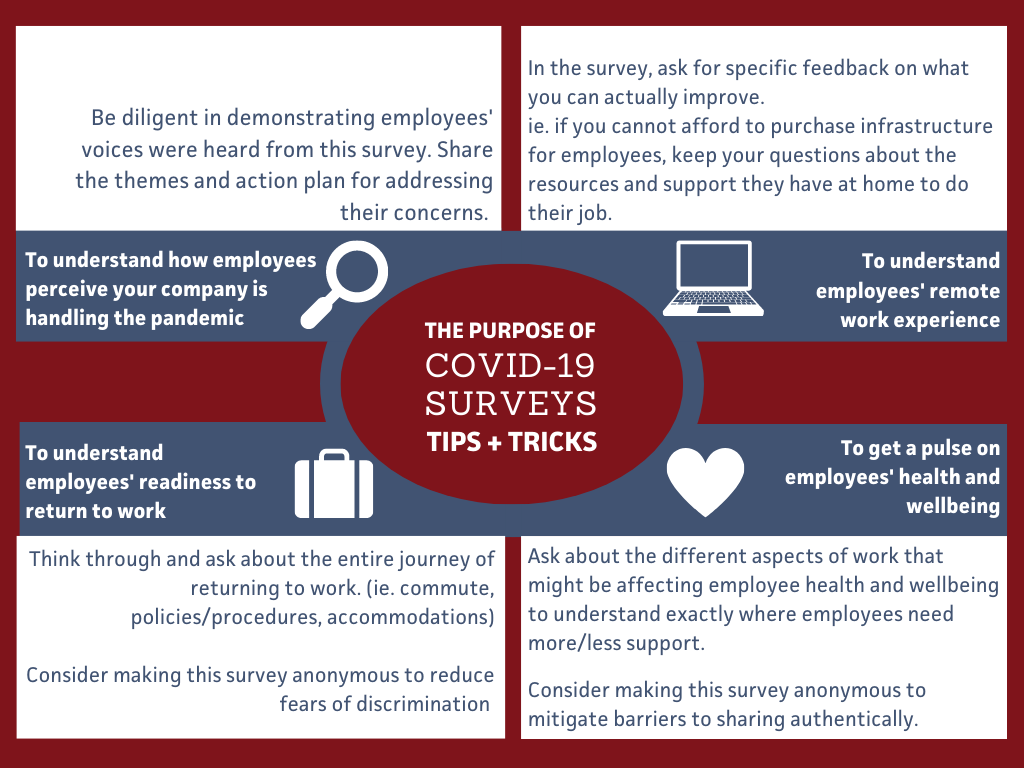Are you facing return to work decisions? Survey the situation! What do surveys have to do with returning to work as COVID-19 restrictions lighten: read on to find out. Keep an eye out for detailed tips and tricks as well as our free survey tool!
We have been all been through a lot over the past couple of months. If you didn’t already know… we have been adjusting to a new normal in the wake of a global pandemic! As leaders, we have the added responsibility of making big decisions for the sustainability of our company, keeping our employees engaged and supported, and undergoing our own stresses and changes in our home lives. And we’re not even close to the end of it: a new change is coming.
As we enter the next phase of the COVID-19 pandemic, our lives are surely going to change again. Except this time, we know it’s coming. This time, we have an opportunity to proactively respond, not react.
“What do my employees need to feel comfortable returning to work? How connected to the company are my employees?” Are we ready to return to work? These questions are frequently asked by employers and managers, but often leads to the biggest question of all: “How do I get these questions answered from my employees, in a clear and easy way?!”
We have the answer: Surveys! Surveys are an essential listening and prediction tool—especially right now. Surveys unlock an immense opportunity to access all the information we need and use it to make precise and data-driven decisions.
Combined with our Survey Tool, we offer advice on when and how to use organizational surveys to collect the answers you need to transition employees back to the workplace, safely and comfortably.
What is the purpose of your COVID-19 Return to Work Survey?

GOAL 1: To understand employee’s thoughts about how your company is handling the pandemic.
- Action/outcome: Continue doing the things that employees recognize/appreciate and change/improve the things they raise as a challenge.
- Make sure to:
- Communicate a summary of themes with employees, and a plan for how you will change/work on the concerns they raised.
- In a survey like this, people want to be heard, and engagement can quickly diminish if people share their vulnerable thoughts/feelings and it’s not acknowledged.
- In your communication, you can share that not everything can/will be changed (or changed quickly) but let people know they were heard and you’re working on it.
GOAL 2: To understand employee’s thoughts about their remote work environment and how your company can improve their experience.
- Action/outcome: Find patterns in the remote work experience and improve the remote work experience where you can.
- Make sure to:
- Communicate a summary of themes with employees, and a plan for how you will change/work on the concerns they raised.
- In a survey like this, people want to be heard, and engagement can quickly diminish if people share their vulnerable thoughts/feelings and it’s not acknowledged.
- In your communication, you can share that not everything can/will be changed (or changed quickly) but let people know they were heard and you’re working on it.
GOAL 2: To understand employee’s thoughts about their remote work environment and how your company can improve their experience.
- Action/outcome: Find patterns in the remote work experience and improve the remote work experience where you can.
- Make sure to:
- Ask for feedback specific to what you can realistically improve. For example, if you can’t afford to buy employees infrastructure, do not ask them about it. Instead, you can keep these questions about the resources and support they have at home to do their job well.
GOAL 3: To understand employee’s thoughts about returning to work, and to support employers in ensuring these employees have everything they need for a smooth transition.
- Action/outcome: Find the pain points and where employees might be hesitant about returning to the workplace. Think through the entire employee journey to and from work and ask about various elements of it to understand where they might be uncomfortable. For example, ask about their understanding of policies/procedures, workplace expectations, work commute, accommodations for kids, and any high-risk considerations at home.
- Make sure to:
- Consider making this survey anonymous! People might be less willing to share their concerns in fear of being an outsider or judged for having different views.
- Consider providing a space for questions/concerns as well as a place to share the positive things the organizations have done that impacted the employee experience. Simply speaking, people are less likely to be biassed when they’re asked for both positive and negative feedback.
GOAL 4: To understand the sentiment of employees around health and safety. Do they have the physiological and social support they need? How is their workload?
- Action/outcome: Find the areas your employees are struggling with / where your organization can provide more support to employees’ wellbeing; to know what resources are needed.
- Make sure to:
- Consider making this survey anonymous (see above)
- Understand the sentiment of employees around three distinct factors of physical health and safety: clear leadership & expectations, physiological & social support, and workload management in these trying times.
Ready to implement a survey and return to work? Get yours here or say hello: [email protected].